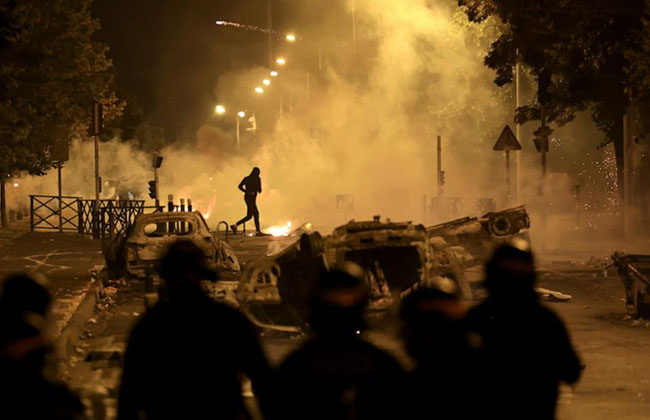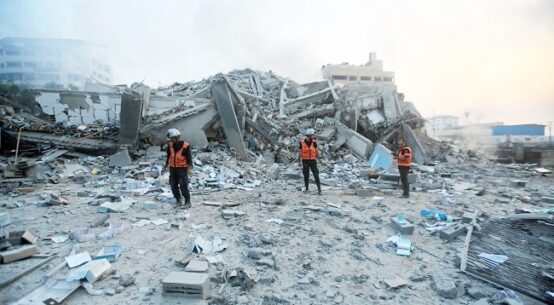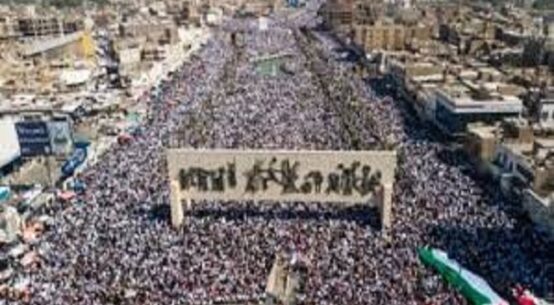
Protesters erected barricades, lit fires and shot fireworks at police who responded with tear gas and water cannons in French streets overnight as tensions grew over the deadly police shooting of a 17-year-old that has shocked the nation. More than 600 people were arrested and at least 200 police officers injured as the government struggled to restore order on a third night of unrest.
Armored police vehicles rammed through the charred remains of cars that had been flipped and set ablaze in the northwestern Paris suburb of Nanterre, where a police officer shot the teen identified only by his first name, Nahel. On the other side of Paris, protesters lit a fire at the city hall of the suburb of Clichy-sous-Bois and set a bus depot ablaze in Aubervilliers.
In several Paris neighborhoods, groups of people hurled firecrackers at security forces. The police station in the city’s 12th district was attacked, while some shops were looted along Rivoli street, near the Louvre museum, and at the Forum des Halles, the largest shopping mall in central Paris.
In the Mediterranean port city of Marseille, police sought to disperse violent groups in the city center, regional authorities said.
President Emmanuel Macron planned to leave an EU summit in Brussels, where France plays a major role in European policymaking, to return to Paris and hold an emergency security meeting Friday.
Some 40,000 police officers were deployed to quell the protests. Police detained 667 people, the interior minister said; 307 of those were in the Paris region alone, according to the Paris police headquarters.
Around 200 police officers were injured, according to a national police spokesperson. No information was available about injuries among the rest of the population.
Interior Minister Gerald Darmanin on Friday denounced what he called a night of “rare violence.” His office described the arrests as a sharp increase on previous operations as part of an overall government efforts to be “extremely firm” with rioters.
The government has stopped short of declaring a state of emergency – a measure taken to quell weeks of rioting around France that followed the accidental death of two boys fleeing police in 2005.
The police officer accused of pulling the trigger Tuesday was handed a preliminary charge of voluntary homicide after prosecutor Pascal Prache said his initial investigation led him to conclude “the conditions for the legal use of the weapon were not met.” Preliminary charges mean investigating magistrates strongly suspect wrongdoing but need to investigate more before sending a case to trial.
The detained police officer’s lawyer, speaking on French TV channel BFMTV, said the officer was sorry and “devastated.” The officer did what he thought was necessary in the moment, attorney Laurent-Franck Lienard told the news outlet.
“He doesn’t get up in the morning to kill people,” Lienard said of the officer, whose name has not been released as per French practice in criminal cases. “He really didn’t want to kill.”
The shooting captured on video shocked France and stirred up long-simmering tensions between police and young people in housing projects and other disadvantaged neighborhoods.
The teenager’s family and their lawyers haven’t said the police shooting was race-related and they didn’t release his surname or details about him.
Still, anti-racism activists renewed complaints about police behavior.
“We have to go beyond saying that things need to calm down,” said Dominique Sopo, head of the campaign group SOS Racisme. “The issue here is how do we make it so that we have a police force that when they see Blacks and Arabs, don’t tend to shout at them, use racist terms against them and in some cases, shoot them in the head.”
Race was a taboo topic for decades in France, which is officially committed to a doctrine of colorblind universalism. But some increasingly vocal groups argue that this consensus conceals widespread discrimination and racism.
Deadly use of firearms is less common in France than in the United States, although 13 people who didn’t comply with traffic stops were fatally shot by French police last year. This year, another three people, including Nahel, have died under similar circumstances. The deaths have prompted demands for more accountability in France, which also saw protests against racial injustice after George Floyd’s killing by police in Minnesota.
In Nanterre, a peaceful march Thursday afternoon in honor of Nahel was followed by escalating confrontations, with smoke billowing from cars and garbage bins set ablaze.
Tensions rose in places across France throughout the day. In the usually tranquil Pyrenees town of Pau in southwestern France, a Molotov cocktail was thrown at a police office, national police said. Vehicles were set on fire in Toulouse and a tramway train was torched in a suburb of Lyon, police said. Some towns, such as Clamart on the French capital’s southwest suburbs and Neuilly-sur-Marne in the eastern suburbs, imposed precautionary overnight curfews.
Bus and tram services in the Paris area shut as a precaution, and many tram lines remained shut for Friday morning rush hour.
The unrest extended as far as Belgium’s capital Brussels, where about a dozen people were detained during scuffles related to the shooting in France and several fires were brought under control.
Prache, the Nanterre prosecutor, said officers tried to stop Nahel because he looked so young and was driving a Mercedes with Polish license plates in a bus lane. He allegedly ran a red light to avoid being stopped then got stuck in traffic.
Both officers said they drew their guns to prevent him from fleeing. The officer who fired the shot said he feared he and his colleague or someone else could be hit by the car, according to Prache.
The scenes in France’s suburbs echoed 2005, when the deaths of 15-year-old Bouna Traore and 17-year-old Zyed Benna led to three weeks of riots, exposing anger and resentment in neglected housing projects. The boys were electrocuted after hiding from police in a power substation in Clichy-sous-Bois.


